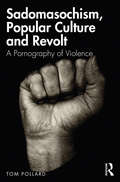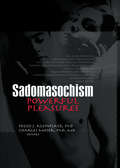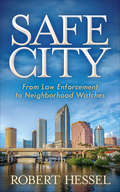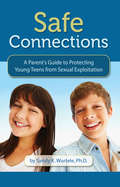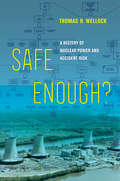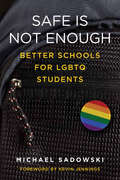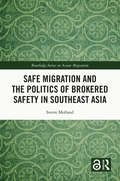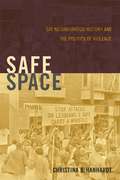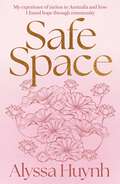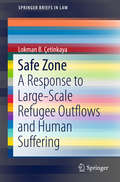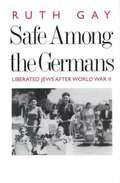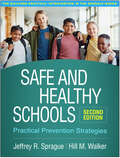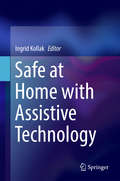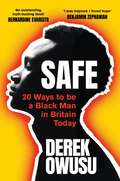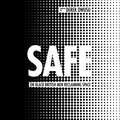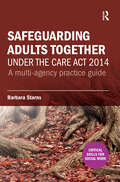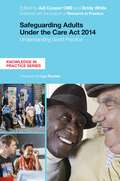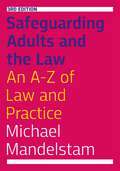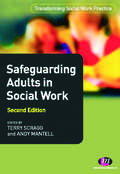- Table View
- List View
Sadomasochism, Popular Culture and Revolt: A Pornography of Violence
by Tom PollardSadomasochism, Popular Culture and Revolt: A Pornography of Violence explores powerful connections between violent pornography and current gender wars, generational conflicts, political struggles, and racial and ethnic unrest. Long before these conflicts dominated headlines worldwide, they become embedded and contextualized in popular culture. Tracing the history of today’s popular porn genres, including torture porn, revenge porn, war porn, and fascist porn, Tom Pollard reveals a "sadomasochistic trope" of fictional and real sexual violence and sexual justice that had largely remained hidden and suppressed. Today it has exploded into public awareness by mass movements like #MeToo demanding justice for sexual assault victims. This movement joins other recent social movements, including Black Lives Matter and advocates of safety from gun violence, which, along with #MeToo, constitute a "revolt of submissives" no longer willing to endure unwanted violence. This thoughtful examination of the history and content of violent pornography reveals portentous patterns and developing trends. By examining pornography’s violent content, Pollard forces us to confront wider social and cultural violence. Sadomasochism, Popular Culture and Revolt will be of great interest to scholars of gay and lesbian studies and queer studies, while being a vital text for undergraduate and graduate instructors of social movement studies in sociology, political science, American Studies, and history.
Sadomasochism: Powerful Pleasures
by Peggy J. Kleinplatz Charles MoserA book that dispels the myths about those who prefer to go beyond "vanilla" sexSadomasochism: Powerful Pleasures is a comprehensive exploration of the entire sexual subculture that lies on the cutting edge of society. The mental health professions and society have marginalized people who practice sadomasochism (SM).This interdisciplinary collection dispels myths surrounding SM, bringing together leading scholars from the fields of sexology, psychology, sociology, and medicine, alongside queer studies and sexual minority advocacy. Experts such as Thomas S. Weinberg, PhD, Susan Wright, MA, Margaret Nichols, PhD, Odd Reiersol, PhD, Svein Skeid, Rebecca F. Plante, PhD, Niklas Nordling, MPsych, and N. Kenneth Sandnabba, PhD, among other stellar authorities, reveal research findings, clinical data, and critical thinking about sexuality that lies beyond "vanilla."To gain a broader understanding of human sexuality, the study of SM is crucial for what it reveals about us as sexual beings. The text discusses the results of research into practitioners&’ behaviors and perspectives, the prevalence of SM behaviors in today&’s culture, and stresses the need for greater tolerance and understanding. The realization of SM desires and their acceptance are explored in detail. This unflinching look at the world and the people of SM will guide scholars and lay people alike into a more sensitive, sex-friendly viewpoint of the people society calls "kinky."Sadomasochism: Powerful Pleasures answers questions such as: What is the nature of SM relationships? What are the values and motives of SM participants? How do mental health professionals regard and treat SM practitioners? Should sadomasochism continue to be classified as a mental illness? What is the legal status of SM and what are the consequences of discrimination against SM practitioners? Does increasing visibility of SM imagery decrease stigma or create added problems? What can ordinary lovers learn from those we have marginalized about the farther reaches of human erotic potential?Sadomasochism: Powerful Pleasures is valuable, insightful reading for mental health professionals, students, sex educators, sex counselors, sex therapists, sex researchers, sexual health workers, sociologists, sexual minority groups, and anyone interested in learning more about the sexual pleasures that lie beyond the traditional.
Safe City: From Law Enforcement to Neighborhood Watches
by Robert HesselA timely books that details the concerted effort and integration of new technology it takes to make communities safer for everyone. It&’s a basic human right to feel and be safe in your community—where you live, work, and play. But, few people know or understand everything it takes to make this possible, including making high-tech solutions available to local law enforcement and first responders. From fire departments detecting fires within seconds with thermal imaging to police departments detecting gunfire immediately through gunshot detection sensors, technology continues to evolve daily. Even surveillance cameras have taken great strides from the grainy images of years past, and just one camera can make a difference (read about how police identified the Boston Marathon bombers through a department store&’s video camera inside!). Safe City teaches the public how to harden targets and protect their homes, businesses, communities, themselves, and their loved ones. It takes a community effort to help reduce and prevent crime, and Safe City answers the questions people have along with pointing out many more that should be asked. &“As someone who is politically active, and involved with urban development, this book is like a playbook for mayors, city council, and county commissioners.&”—Topher Morrison, author of The Profitable CEO and managing director of Key Person of Influence &“Provides a fact-filled insight into community policing . . . This a good read that delivers a solid understanding of the &‘how and why&’ of the future of community policing in America.&” —Retired Deputy Chief Metro Detroit Police Department
Safe Connections
by Sandy K. WurteleThough children grow older, concerns about the danger of sexual abuse may persist for some parents. This accessible manual provides help in continuing discussions about personal safety with preteens and teens, and it alerts parents to the issues of online predators, sexting, and sexual exploitation—especially in what appear to be romantic relationships. It also provides practical advice for those who want to ensure that their children are safe with the parents’ own friends or romantic partners. Safe Connections, with its detailed lists of warning signs that an adolescent is being abused or is becoming an abuser, is ideal for use in school safety curricula.
Safe Enough?: A History of Nuclear Power and Accident Risk
by Thomas R. WellockSince the dawn of the Atomic Age, nuclear experts have labored to imagine the unimaginable and prevent it. They confronted a deceptively simple question: When is a reactor "safe enough" to adequately protect the public from catastrophe? Some experts sought a deceptively simple answer: an estimate that the odds of a major accident were, literally, a million to one. Far from simple, this search to quantify accident risk proved to be a tremendously complex and controversial endeavor, one that altered the very notion of safety in nuclear power and beyond. Safe Enough? is the first history to trace these contentious efforts, following the Atomic Energy Commission and the Nuclear Regulatory Commission as their experts experimented with tools to quantify accident risk for use in regulation and to persuade the public of nuclear power’s safety. The intense conflict over the value of risk assessment offers a window on the history of the nuclear safety debate and the beliefs of its advocates and opponents. Across seven decades and the accidents at Three Mile Island, Chernobyl, and Fukushima, the quantification of risk has transformed both society’s understanding of the hazards posed by complex technologies and what it takes to make them safe enough.
Safe Is Not Enough: Better Schools for LGBTQ Students (Youth Development and Education Series)
by Michael SadowskiSafe Is Not Enough illustrates how educators can support the positive development of LGBTQ students in a comprehensive way so as to create truly inclusive school communities. Using examples from classrooms, schools, and districts across the country, Michael Sadowski identifies emerging practices such as creating an LGBTQ-inclusive curriculum; fostering a whole-school climate that is supportive of LGBTQ students; providing adults who can act as mentors and role models; and initiating effective family and community outreach programs. While progress on LGBTQ issues in schools remains slow, in many parts of the country schools have begun making strides toward becoming safer, more welcoming places for LGBTQ students. Schools typically achieve this by revising antibullying policies and establishing GSAs (gay-straight student alliances). But it takes more than a deficit-based approach for schools to become places where LGBTQ students can fulfill their potential. In Safe Is Not Enough, Michael Sadowski highlights how educators can make their schools more supportive of LGBTQ students&’ positive development and academic success.
Safe Migration and the Politics of Brokered Safety in Southeast Asia (Routledge Series on Asian Migration)
by Sverre MollandThe book investigates how the United Nations, governments, and aid agencies mobilise and instrumentalise migration policies and programmes through a discourse of safe migration. Since the early 2000s, numerous non-governmental organizations (NGOs), UN agencies, and governments have warmed to the concept of safe migration, often within a context of anti-trafficking interventions. Yet, both the policy-enthusiasm for safety, as well as how safe migration comes into being through policies and programs remain unexplored. Based on seven years of ethnographic fieldwork in the Mekong region, this is the first book that traces the emergence of safe migration, why certain aid actors gravitate towards the concept, as well as how safe migration policies and programmes unfold through aid agencies and government bodies. The book argues that safe migration is best understood as brokered safety. Although safe migration policy interventions attempt to formalize pre-emptive and protective measures to enhance labour migrants’ well-being, the book shows through vivid ethnographic details how formal migration assistance in itself depends on – and produces – informal asnd mediated practices. The book offers unprecedented insights into what safe migration policies look like in practice. It is an innovate contribution to contemporary theorizing of contemporary forms of migration governance and will be of interest to sociologists, anthropologists, political scientists, and human geographers working within the fields of Migration studies, Development Studies, as well as Southeast Asian and Global Studies.
Safe Space: Gay Neighborhood History and the Politics of Violence
by Christina B. HanhardtWinner, 2014 Lambda Literary Award in LGBT Studies Since the 1970s, a key goal of lesbian and gay activists has been protection against street violence, especially in gay neighborhoods. During the same time, policymakers and private developers declared the containment of urban violence to be a top priority. In this important book, Christina B. Hanhardt examines how LGBT calls for "safe space" have been shaped by broader public safety initiatives that have sought solutions in policing and privatization and have had devastating effects along race and class lines. Drawing on extensive archival and ethnographic research in New York City and San Francisco, Hanhardt traces the entwined histories of LGBT activism, urban development, and U. S. policy in relation to poverty and crime over the past fifty years. She highlights the formation of a mainstream LGBT movement, as well as the very different trajectories followed by radical LGBT and queer grassroots organizations. Placing LGBT activism in the context of shifting liberal and neoliberal policies, Safe Space is a groundbreaking exploration of the contradictory legacies of the LGBT struggle for safety in the city.
Safe Space: Gay Neighborhood History and the Politics of Violence
by Christina B. HanhardtWinner, 2014 Lambda Literary Award in LGBT StudiesSince the 1970s, a key goal of lesbian and gay activists has been protection against street violence, especially in gay neighborhoods. During the same time, policymakers and private developers declared the containment of urban violence to be a top priority. In this important book, Christina B. Hanhardt examines how LGBT calls for "safe space" have been shaped by broader public safety initiatives that have sought solutions in policing and privatization and have had devastating effects along race and class lines.Drawing on extensive archival and ethnographic research in New York City and San Francisco, Hanhardt traces the entwined histories of LGBT activism, urban development, and U.S. policy in relation to poverty and crime over the past fifty years. She highlights the formation of a mainstream LGBT movement, as well as the very different trajectories followed by radical LGBT and queer grassroots organizations. Placing LGBT activism in the context of shifting liberal and neoliberal policies, Safe Space is a groundbreaking exploration of the contradictory legacies of the LGBT struggle for safety in the city.
Safe Space: My experience of racism in Australia and how I found hope through community
by Alyssa Huynh'A searingly honest and impassioned account of being an advocate in the social media era, Alyssa's voice is fierce, urgent and brave; and filled with deep familial love. This book burns with an urgency and clarion call to action.' Alice Pung, author of One Hundred Days This is a book for anyone who believes that racism has no place in Australia&’s future and is ready to take action.&‘I&’ve played the role of the quiet and embarrassed Asian girl who shyly laughs along more than I should have in my lifetime. Enough is enough.&’ Growing up, Alyssa Huynh heard stories from her family about their journey from Vietnam to Australia following the fall of Saigon and the racism they experienced upon arrival. While the discrimination she faced was different, she never quite felt like she belonged either. Longing for a safe space, she turned to the internet. Through sharing her writing online, she created a supportive community for fellow Asians and people of colour with similar experiences, as well as for allies. When some of her views went viral, important conversations were sparked, but there was also racist backlash – showing her that the work was necessary and her voice had impact. Honest and heartfelt, Safe Space is unapologetically angry and sincerely hopeful. Alyssa explores the challenges she has faced as an Asian-Australian and those that made her the advocate she is today. She also offers practical advice, both to those who are victims of racism and wish to add their voice to the discourse or deepen their connection to their cultural identities, and to allies who want to learn more about how they can meaningfully show their support.
Safe Zone: A Response to Large-Scale Refugee Outflows and Human Suffering (SpringerBriefs in Law)
by Lokman B. ÇetinkayaUsing legal arguments consistent with international law, this book explores whether and under which circumstances a State (or States) may establish and militarily enforce safe zones in countries that produce large-scale refugee outflows so as to protect its (or their) own interests by averting said outflows, as well as to alleviate human suffering in today’s world of civil and internal warfare.Though large-scale refugee outflows have become an increasingly frequent problem in inter-state relations, international law offers no clear remedy. Accordingly, interpretation and adaptation of the existing rules and principles of international law, in addition to State practice and the jurisprudence of international courts, are required in order to find appropriate and lawful responses to such situations. The book examines countermeasures, necessity and humanitarian intervention as possible legal grounds to justify the establishment of safe zones.Since the proposal of a safe zone for Syria remains on the international community’s agenda, the specific conditions of this case are particularly addressed in order to assess the suitability and legality of a possible safe zone in Syria.
Safe among the Germans: Liberated Jews After World War II
by Ruth GayTelling the little-known story of why a quarter-million Jews, survivors of death camps and forced labor, sought refuge in Germany after World War II, Gay examines the contrasting lives of Jews in the two postwar Germanys.
Safe and Healthy Schools, Second Edition: Practical Prevention Strategies (The Guilford Practical Intervention in the Schools Series)
by Jeffrey R. Sprague Hill M. WalkerNow in a fully revised and updated second edition, this authoritative resource provides a complete toolkit for designing and implementing an evidence-based school safety plan. Foremost experts guide practitioners to understand and prevent violence, bullying, and peer harassment in grades K–12. Best practices are reviewed for creating a positive school climate and establishing effective security and crisis response procedures. The authors describe ways to identify and support behaviorally at-risk students across multiple tiers of intervention, beginning with universal screening. In a convenient large-size format, the book includes reproducible planning tools. Purchasers get access to a Web page where they can download and print the reproducible materials. New to This Edition *Reflects over 15 years of research advances, new initiatives, and the growth of universal prevention models. *Grounded in current positive behavioral interventions and supports (PBIS) practices; also incorporates restorative discipline, social–emotional learning, and trauma-informed practices. *State-of-the-art behavioral screening and threat assessment methods are integrated throughout. *Discussions of timely topics, including cyberbullying, the role and limitations of policing in schools, and racial/ethnic disparities in discipline. This book is in The Guilford Practical Intervention in the Schools Series, edited by Sandra M. Chafouleas.
Safe at Home with Assistive Technology
by Ingrid KollakThis book describes how assistive technology can help handicapped, elderly and acutely sick people to manage their daily lives better and stay safe in the home. It discusses how safety is understood from an ethical, technical and social perspective, and offers examples of the problems that users, their helpers and professional carers have with assistive technology in everyday situations. The book provides insights from user-centred research and uses photographs to illustrate the main topic: how users and technology can work together to ensure safety. User-focused and combining experience with research, the book will interest users of these kinds of technology, health professionals who might introduce and/or prescribe them, engineers who develop and sell assistive technological gadgets, and architects who build safe homes - as well as researchers and students who work in these fields. It provides an overview of the existing technology, examines ways to test its effectiveness from the point of view of users, health professionals and researchers from different fields (architecture, education, engineering, facility management, medicine, nursing, occupational therapy, rehabilitative medicine, physiotherapy, social science and speech therapy), and lists useful addresses, websites and literature
Safe: 20 Ways to be a Black Man in Britain Today 'Everyone should read it' Bernardine Evaristo
by Derek Owusu'It's brave and honest, and not a moment too soon.' Afua Hirsch, Brit(ish)'[An] outstanding myth-busting book. Everyone should read it.' Bernardine EvaristoWhat is the experience of Black men in Britain today? Never has the conversation about racism and inclusion been more important; there is no better time to explore this question and give Black British men a platform to answer it. SAFE: 20 Ways to be a Black Man in Britain Today is that platform. Including essays from top poets, writers, musicians, actors and journalists, this timely and accessible book is in equal parts a celebration, a protest, a call to arms, and a dismantling of the stereotypes surrounding being a Black man. What does it really mean to reclaim and hold space in the landscape of our society? Where do Black men belong in school, in the media, in their own families, in the conversation about mental health, in the LGBTQ+ community, in grime music - and how can these voices inspire, educate and add to the dialogue of diversity already taking place? Following on from discussions raised by Natives and Why I'm No Longer Talking to White People About Race, this collection takes readers on a rich and varied path to confront and question the position of Black men in Britain today, and shines a light on the way forward.Contributors: Alex Holmes, Alex Wheatle, Aniefiok 'Neef' Ekpoudom, Courttia Newland, Derek Oppong, Derek Owusu, Gbontwi Anyetei; Jesse Bernard, JJ Bola; Joseph Harker; Jude Yawson; Kenechukwu Obienu; Kobna Holdbrook-Smith; Nels Abbey; Okechukwu Nzelu; Robyn Travis; Stephen Morrison-Burke; Suli Breaks; Symeon Brown; Yomi Sode
Safe: On Black British Men Reclaiming Space
by Derek Owusu'This is an inspiring collection of essays ... Every page of this book breaks down stereotypes of what being a Black man is.' Benjamin Zephaniah What is the experience of Black men in Britain? With continued conversation around British identity, racism and diversity, there is no better time to explore this question and give Black British men a platform to answer it. SAFE: On Black British Men Reclaiming Space is that platform. Including essays from top poets, writers, musicians, actors and journalists, this timely and accessible book brings together a selection of powerful reflections exploring the Black British male experience and what it really means to reclaim and hold space in the landscape of our society. Where do Black men belong in school, in the media, in their own families, in the conversation about mental health, in the LGBT community, in grime music - and how can these voices inspire, educate and add to the dialogue of diversity already taking place? Following on from discussions raised by The Good Immigrant and Why I'm No Longer Talking to White People About Race, this collection takes readers on a rich and varied path to confront and question the position of Black men in Britain today, and shines a light on the way forward.Read by Contributors: Alex Holmes, Alex Wheatle, Aniefiok 'Neef' Ekpoudom, Courttia Newland, Derek Oppong, Derek Owusu, Gbontwi Anyetei; Jesse Bernard, JJ Bola; Joseph Harker; Jude Yawson; Kenechukwu Obienu; Kobna Holdbrook-Smith; Nels Abbey; Okechukwu Nzelu; Robyn Travis; Stephen Morrison-Burke; Suli Breaks; Symeon Brown; Yomi Sode(p) Orion Publishing Group 2019
Safeguarding Across the Life Span
by June Keeling David GooseyConsidering safeguarding across the life span and placing it within a multiagency context, this book gives students a grounding to the key issues in safeguarding today, highlighting the key skills and knowledge necessary for effective practice along the way. It includes reference to the latest legislation, skills for practice, a breadth of contexts and service-user groups, drawing on a range of case studies, activities, reflective questions and recommending reading from across health and social care. Locating age specific concerns in context and divided into sections which cover every stage of life, it addresses questions of culture, gender and problems frequently encountered in practice and what these mean for safeguarding and law.
Safeguarding Across the Life Span
by June Keeling David GooseyConsidering safeguarding across the life span and placing it within a multiagency context, this book gives students a grounding to the key issues in safeguarding today, highlighting the key skills and knowledge necessary for effective practice along the way. It includes reference to the latest legislation, skills for practice, a breadth of contexts and service-user groups, drawing on a range of case studies, activities, reflective questions and recommending reading from across health and social care. Locating age specific concerns in context and divided into sections which cover every stage of life, it addresses questions of culture, gender and problems frequently encountered in practice and what these mean for safeguarding and law.
Safeguarding Adults Online: Perspectives on Rights to Participation
by Andy Phippen Emma BondThis much-needed volume fills an overlooked gap in adult safeguarding – the digital arena – in providing a comprehensive overview of policy and practice in supporting vulnerable adults online. Providing an essential analysis illustrated by recent court rulings and case studies, the authors advocate for the effective support of adults with learning disabilities and/or mental capacity issues in their digital lives without compromising their privacy and participation rights. The text balances a theoretical exploration of the tensions between participation and protection, legislation, human rights, professional biases and social wrongs. It encourages a critical approach in adopting both a practical and realistic understanding for policy makers, professionals and students in social work, law and adult social care.
Safeguarding Adults Together under the Care Act 2014: A multi-agency practice guide
by Barbara StarnsThe Care Act 2014 has been criticised for the lack of a clear process for professionals to follow. With its emphasis on the personal individual approach to safeguarding, professionals have sometimes felt unclear as to how they should deliver safeguarding support. Written by a practitioner, with an academic background, Safeguarding Adults Together seeks to provide that vital guidance. Whilst there is an absence of process in the Act, there is still a clear set of safeguarding elements which when put together provide a framework of operation for professionals to become more effective in their safeguarding practice. Professionals tend each to look at a particular aspect of safeguarding, but it is only when the whole framework is demonstrated can practitioners understand how they can best provide good safeguarding support to adults who need their help. This book provides the reader with that knowledge and understanding about how adult safeguarding works by translating the Care Act into practice.This is a follow book to the successful The Social Worker’s Guide to the Care Act 2014 by Pete Feldon ISBN 9781911106685.Safeguarding Adults: provides a unique safeguarding framework approach that explains what adult safeguarding is and how it works. includes memorable illustrations that explain difficult complex elements of safeguarding is packed with practice case studies and examples to support understanding of safeguarding and application of knowledge and skill.
Safeguarding Adults Under the Care Act 2014: Understanding Good Practice (Knowledge In Practice Ser.)
by Emily White David Orr Martin Stevens Trish Hafford-Letchfield Rebecca Johnson Michael Preston-Shoot Suzy Braye Marilyn Taylor Sarah Carr Jill Manthorpe Fiona Bateman Jane Lawson Lee-Ann Fenge Adi Cooper Antony Botting Caroline Norrie Daniel Baker Dr Lindsey Pike Dr Sally Lee Dr Tony Stanley John Gunner Linda Tapper Lyn Romeo Nicki Norman Professor Keith Brown Sean Olivier Stephen Martineau Tish ElliottPractice in safeguarding adults is changing, with a shift in approach to ensure it is person-centred and outcome-focused. The Care Act 2014 introduced new safeguarding duties for local authorities, and this book describes what up-to-date practice should look like, and how to provide the best quality care and support for adults who may be at risk of abuse or neglect. Chapters cover core areas of practice according to Care Act and adult safeguarding principles, identify the fundamental skills and knowledge practitioners working in this area should be able to utilise and introduce the emerging challenging issues in the workplace. As well as being invaluable to practitioners working directly in this field, this is also ideally suited to be a text for any social work course or programme on adult safeguarding practice.
Safeguarding Adults and the Law
by Michael MandelstamThe safeguarding of vulnerable adults continues to increase in importance. Safeguarding Adults and the Law, now in its second edition, sets this complex area of work within an extensive legal framework and provides many useful pointers for practitioners and students. The book covers, for example, Department of Health guidelines, human rights, the regulation of health and social care providers, the barring of carers from working with vulnerable adults, care standards tribunal cases, mental capacity, undue influence, assault, battery, wilful neglect, ill treatment, self-neglect, manslaughter, murder, theft, fraud, sexual offences, data protection and the sharing of information. It focuses on how these areas of law apply to vulnerable adults, and uses the large body of case law to bring the law to life. Also covered is how local authorities and the NHS are implicated in causing harm - through abuse, neglect or omission - as exemplified by the independent and public inquiries into the catastrophic events at Stafford Hospital. This fully-updated second edition comprehensively reflects recent changes to the law, and includes many new case studies. It looks forward also to the implications, for safeguarding, of the draft Care and Support Bill 2012. This book will be an essential resource for all those working in community care, adult social work, health care and housing. Those working for local authorities, the NHS, voluntary organisations and students will find it to be essential reading.
Safeguarding Adults and the Law, Third Edition: An A-Z of Law and Practice
by Michael MandelstamSafeguarding Adults and the Law, now in its third edition, sets this complex area of work within an extensive legal framework and provides many useful pointers for practitioners and students. It is now in an A-Z format, enabling quick reference to a wide range of civil and criminal law, and to legal case law.The book covers safeguarding duties under the Care Act 2014 and in particular the making of enquiries by local authorities, safeguarding adults boards, Department of Health guidance, human rights, regulation of health and social care providers, barring of carers from working with vulnerable adults, criminal records certificates, mental capacity, the High Court's inherent jurisdiction, undue influence, assault, battery, wilful neglect, ill treatment, self-neglect, manslaughter, murder, theft, fraud, sexual offences, modern slavery, domestic violence legislation, data protection and the sharing of information.The book focuses on how these areas of law, each with its own set of rules, apply to the practice of safeguarding adults. It contains numerous legal case summaries to bring the law to life. Fully updated, it reflects significant changes to civil and criminal law over the last five years.A critical introduction analyses serious challenges and issues inherent in the current culture of health and social care, and the implications for adult safeguarding.This book will be an essential resource for all those working in social care, health care and the police, as well as the many other agencies involved in safeguarding.
Safeguarding Adults in Social Work
by Andy Mantell Terry ScraggSafeguarding adults has a long history of neglect and scandal, but it is finally starting to gain the recognition it deserves. This book helps students and practitioners to understand this evolving field and to identify ways in which they can develop their own good practice. The first part of the book explores the evolution of concepts and policies for safeguarding adults, with particular reference to the Human Rights Act 1998 and the Capacity Act 2005. In the second section, the focus shifts to good practice in empowering vulnerable adults. The final section focuses on developing effective professional and interprofessional practice.
Safeguarding Adults in Social Work (Transforming Social Work Practice Series)
by Andy Mantell Terry ScraggSafeguarding adults has a long history of neglect and scandal, but it is finally starting to gain the recognition it deserves. This book helps students and practitioners to understand this evolving field and to identify ways in which they can develop their own good practice. The first part of the book explores the evolution of concepts and policies for safeguarding adults, with particular reference to the Human Rights Act 1998 and the Capacity Act 2005. In the second section, the focus shifts to good practice in empowering vulnerable adults. The final section focuses on developing effective professional and interprofessional practice.
